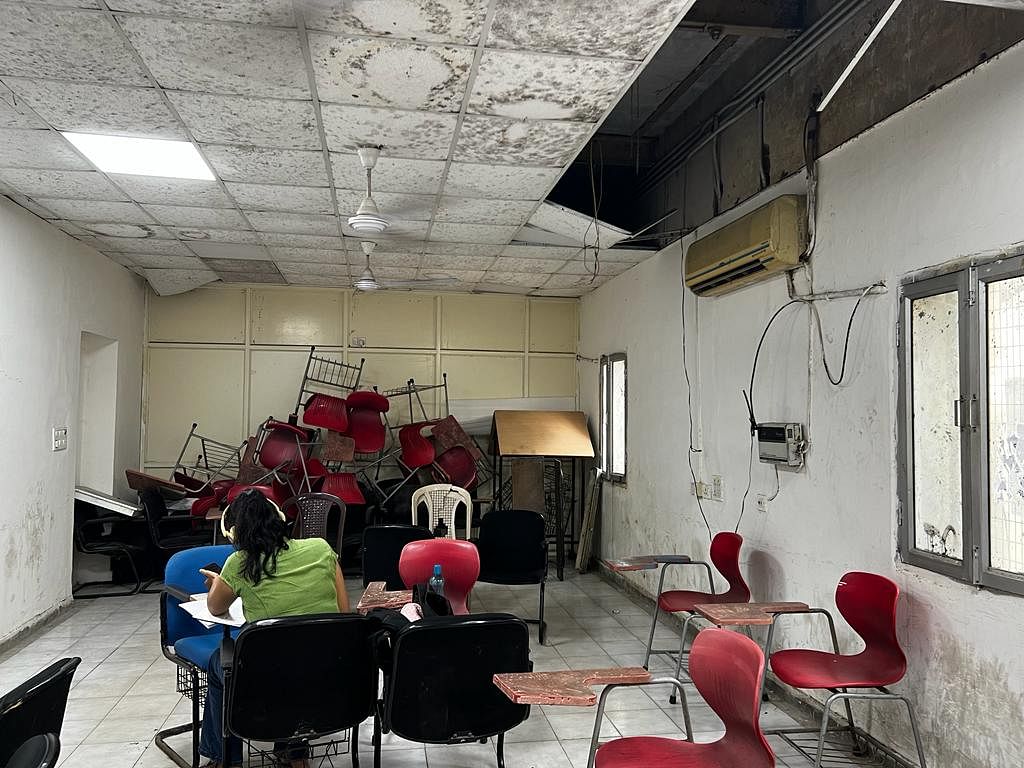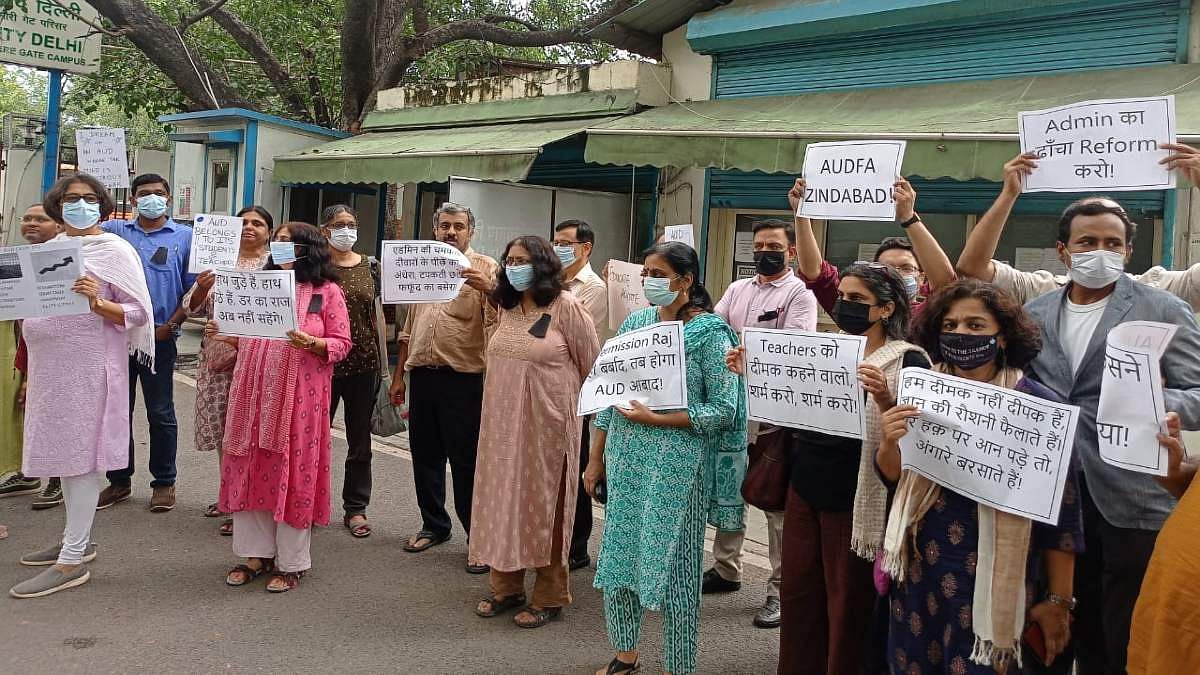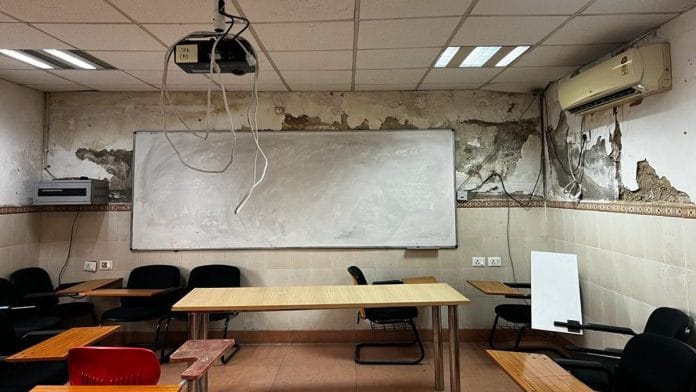New Delhi: In classrooms at the Kashmere Gate campus of Ambedkar University Delhi, where the majority of its 3,500 students are enrolled, the walls are discoloured from seepage. In the common study room, black mould has enveloped the entire ceiling. The room itself resembles a repurposed warehouse, with furniture in disuse stacked in one corner. The toilets — leaking sewage water — are unusable.
Fifteen years after it was set up, the Delhi government-run Dr B.R. Ambedkar University — aimed to focus on research and teaching in social sciences and humanities, guided by Dr B.R. Ambedkar’s vision of bridging equality and social justice with excellence — is an institute in crisis.
Accompanying its crumbling infrastructure, according to AUD insiders, are falling research standards and a growing friction between the faculty and university administration.
In 2016, the multi-campus university was ranked 96 by the central government’s National Institutional Ranking Framework (NIRF), out of 3,565 institutes. Seven years later, as the list of universities assessed grew to 8,565, it has slipped out of the top 200 altogether (ranks beyond 200 are not mentioned on NIRF website).

The university was graded ‘A’ by the National Assessment and Accreditation Council in 2014. Fast forward to 2022, the grade had fallen by a notch to B++.
Data shared by the Ambedkar University Faculty Association (AUDFA) shows that 17 faculty members have resigned in the last two years. Meanwhile, two dozen other faculty members have been holding a protest daily for the last three weeks to express their dissatisfaction with the way the university has been functioning. To ensure student-learning is not affected, the protest has been sandwiched into the one-hour lunch break.
“We don’t have any common areas where we can sit and self-study or even relax between classes,” said a student who didn’t want to be named.
“Even the reading area only has 20 seats, which all Master’s and PhD students have to share. Our classes are not held on time, and, post-pandemic, the semester schedules are all over the place,” the student added.
A professor who is associated with the AUDFA said the administration had on several occasions prevented professors from participating in international conferences and scholarships.
This allegation was denied by Dean Academics Prof Satyaketu Sanskrit, who said they had granted permits to 98 faculty members to participate in national and international conferences, and research recognition awards were given to 24 faculty members in the last 2 years.
Vice-Chancellor Anu Singh Lather acknowledged the institute’s falling NAAC and NIRF ratings, but said AUD was relatively young and working to get back up the rankings.
Referring to the poor state of infrastructure, Lather said they had spent upwards of Rs 15 crore in the last four years for the upkeep of the institution. However, she added, they could only do so much as the campus was set up in a heritage building.
She said that new campuses are scheduled to be set up, but they are awaiting money from the Delhi government.
In 2022, the Delhi government sanctioned Rs 2,306.58 crore in order to accommodate 26,000 new students in the new campuses. However, according to university officials, the Delhi government cabinet has yet to approve the sum.
ThePrint reached Alice Vaz, the secretary for higher education in Delhi government, by mail for a comment on the challenges that the university is facing, but a response is awaited.
Disrepair & neglect
Dr B.R. Ambedkar University, Delhi, was set up in 2008. While its main campus is located at Kashmere Gate, there are two others at Karampura and Lodhi Road. Plots were identified in 2018 to set up campuses in Dheerpur and Rohini as well, but not much activity has taken place since the foundation stone was laid, said AUD professors.
The Kashmere Gate campus is housed in a 400-year-old heritage building complex at the Lothian Road, close to the Metro station.
The university website describes it as “a 3-acre sprawling green campus in the heart [of] old Delhi”.
“AUD campus has good infrastructure in terms of well-stocked libraries, reading rooms, online journals and computer labs,” it says. “Student hostel facility are [sic] available only for girl students. Classrooms are equipped with audio-visual equipment and Wi-Fi connectivity is available throughout the campus.”
However, when ThePrint visited the campus on 31 August, signs of disrepair and neglect were evident.
A part of the ceiling of the student reading area — which had collapsed in December 2022 — still hasn’t been repaired and a gaping hole stands in its stead. The rest of the ceiling is infested with mould — a known health hazard.

Speaking to ThePrint, students and faculty members complained that they do not have adequate drinking water facilities.
“The walls of our classrooms are crumbling, we are inhaling copious amounts of fungus as the ceiling in the students area is heavily mouldy and there is no drinking water on campus,” said a Master’s student.
Added another, “We carry our own water bottles and avoid using the washrooms as they are broken and often leak sewage water.”
The students and faculty members claim that they have fallen ill on several occasions as a result of the unsanitary conditions on campus.
A founding faculty member said “the campus space has always been difficult to manage given that it is an ASI (Archaeological Survey of India)-marked heritage building and no structural changes could have been made to it”.
In light of these challenges, the need for improved infrastructure becomes increasingly critical to support the academic environment and ensure that students have access to adequate facilities.
“But the infrastructure has never been in such poor shape over the years,” the faculty member added.
AUD Registrar Dr Nitin Mallik said their hands were tied by the building’s heritage status. “Given that it is an ASI-protected building, we can only make cosmetic changes to the structure,” he added. “While we have written to the ASI and PWD (Public Works Department) on several occasions, asking for the building to be fixed, we have not received positive responses.”
Dropping rank and research
The dilapidated infrastructure aside, AUD insiders say the university is struggling with its stated purpose of being a centre for academic excellence.
A shortage of faculty members, they said, has led to delayed classes and overburdened teachers. Faculty members also say that the number of research publications and collaborations in the university has reduced.
NIRF data submitted by the AUD shows that, in 2018-19, the university had 40 research projects worth Rs 7.07 crore. This dropped to 10 projects worth Rs 79 lakh in 2020-21.
Prof Sumangala Damodaran, who taught in Delhi University before joining AUD, said its drop in rankings has impacted the amount of research projects the faculty receives.
“I have worked on several collaborative research projects with academics from BRICS nations and have friends there. When we jointly attempted to apply for certain grants for research, I found that I wasn’t eligible as AUD no longer cleared the ranking criteria requirements.”
She said it was a “serious loss”. “Research projects bring not just funding but also provide a great opportunity for students to learn,” she added.
The university, however, said that the number of research projects had primarily dropped due to the pandemic and the long application process for foreign research projects.
“In 2018-19, there were 32 projects, and many projects were in the stage of completion,” they said.
Due to Covid-19, “funding opportunities were affected during 2020 -21”, it added.
Major projects from the University Grants Commission (UGC) and the Indian Council of Social Science Research (ICSSR) and other national and international funding agencies were put on hold, the AUD said.
“It affected two to three years of working. Despite that there were 23 projects in 2019-20,” it added.
In 2022, the faculty applied for 24 projects with ICSSR and 2 got sanctioned. The university has taken steps to fund the remaining projects from the university budget,” it said.
‘Tussle between faculty and administration’
Against this backdrop, teachers have been on protest for three weeks and allege no effort has been made by the AUD administration to hold a dialogue.
In a press statement dated 24 August, the AUDFA said, “AUDFA protests administrative apathy towards the demand for facilitative and inclusive governance.”
The organisation said they were “particularly critical of bureaucratic logjams within the university causing immense delay and non-functioning of the university, along with the lack of functional autonomy in schools and centres”.

“The association stands opposed to the regressive interpretation of UGC rules for faculty promotions, lack of clarity on service rules, and the whimsical application of rules concerning medical benefits for the teaching community.”
Teachers also point fingers of accusation at V-C Lather, saying she has little faith in the staff and has been known to use “objectionable language” against them.
At a steering committee meeting held on 27 July this year, Lather allegedly said that “80 percent of the faculty members were termites”. Lather, however, denied the charge.
Talking about AUD’s performance with respect to NAAC and NIRF, Vice-Chancellor Lather said the parameter on which the university scored poorly in NAAC was research publication (0.94).
“As the accreditation body has been making its norms stricter, the university is trying to keep up with the changing assessment norms,” she added.
She sought to clarify that the university was assessed by NAAC “before her term” started in 2019, but said she expects the grades to improve with the changing NAAC norms.
As for the drop in the NIRF ranking, she said, “Ambedkar University is only 15 years old and a lot of institutions have been added to the rankings over the years. It is a challenge to compete with public and private universities with bigger funding and campuses.”
This is an updated version of the report
(Edited by Sunanda Ranjan)






